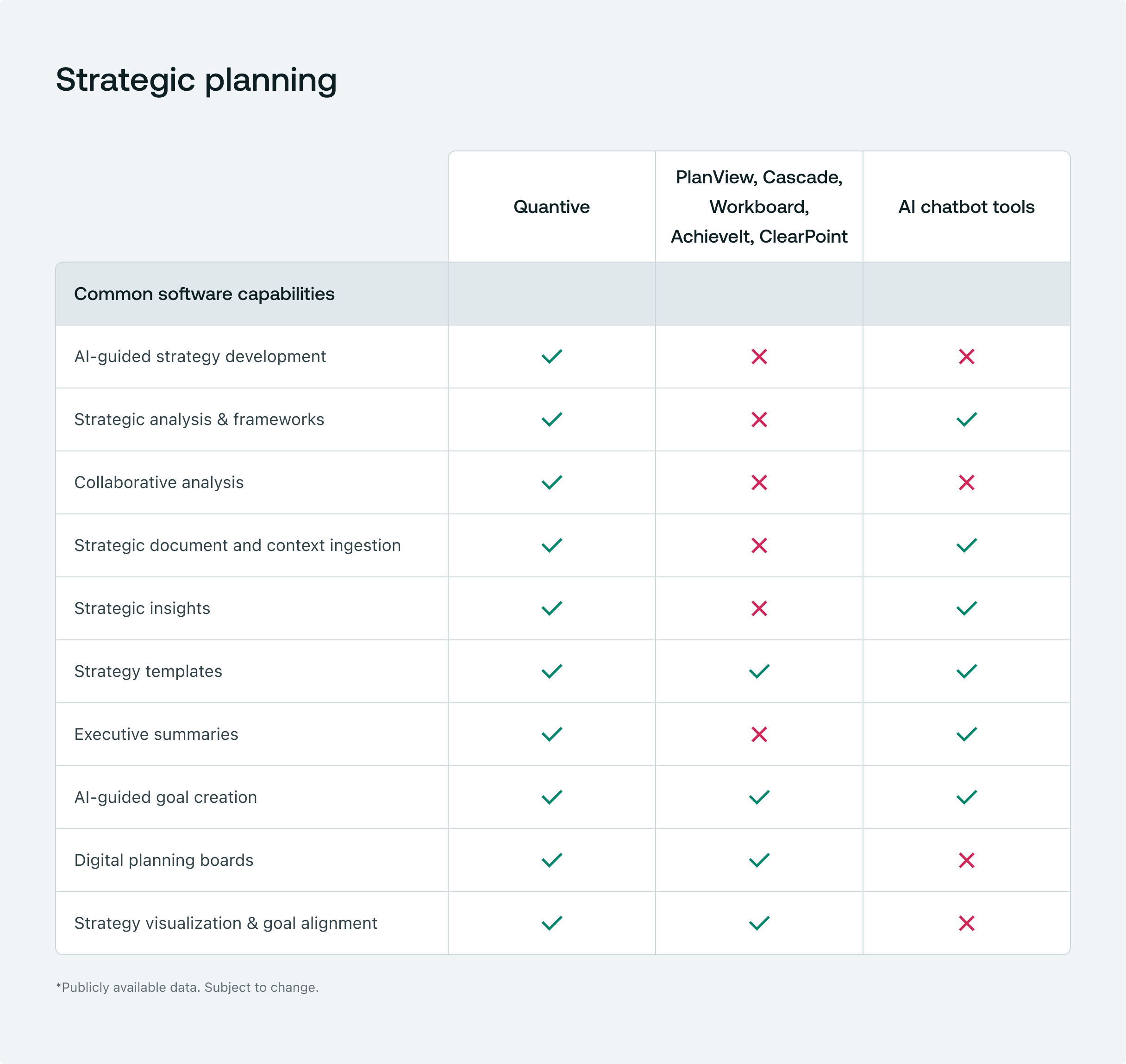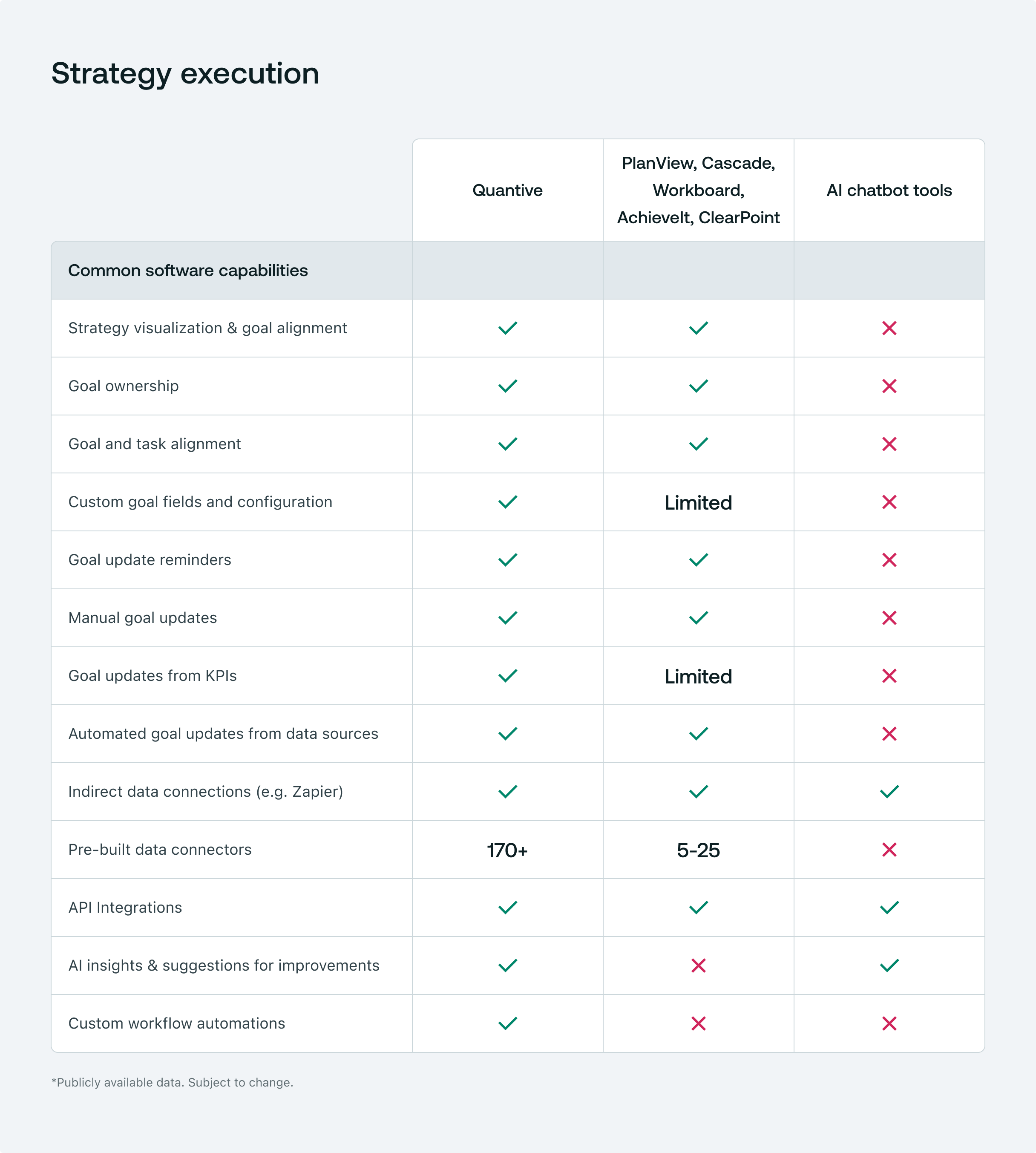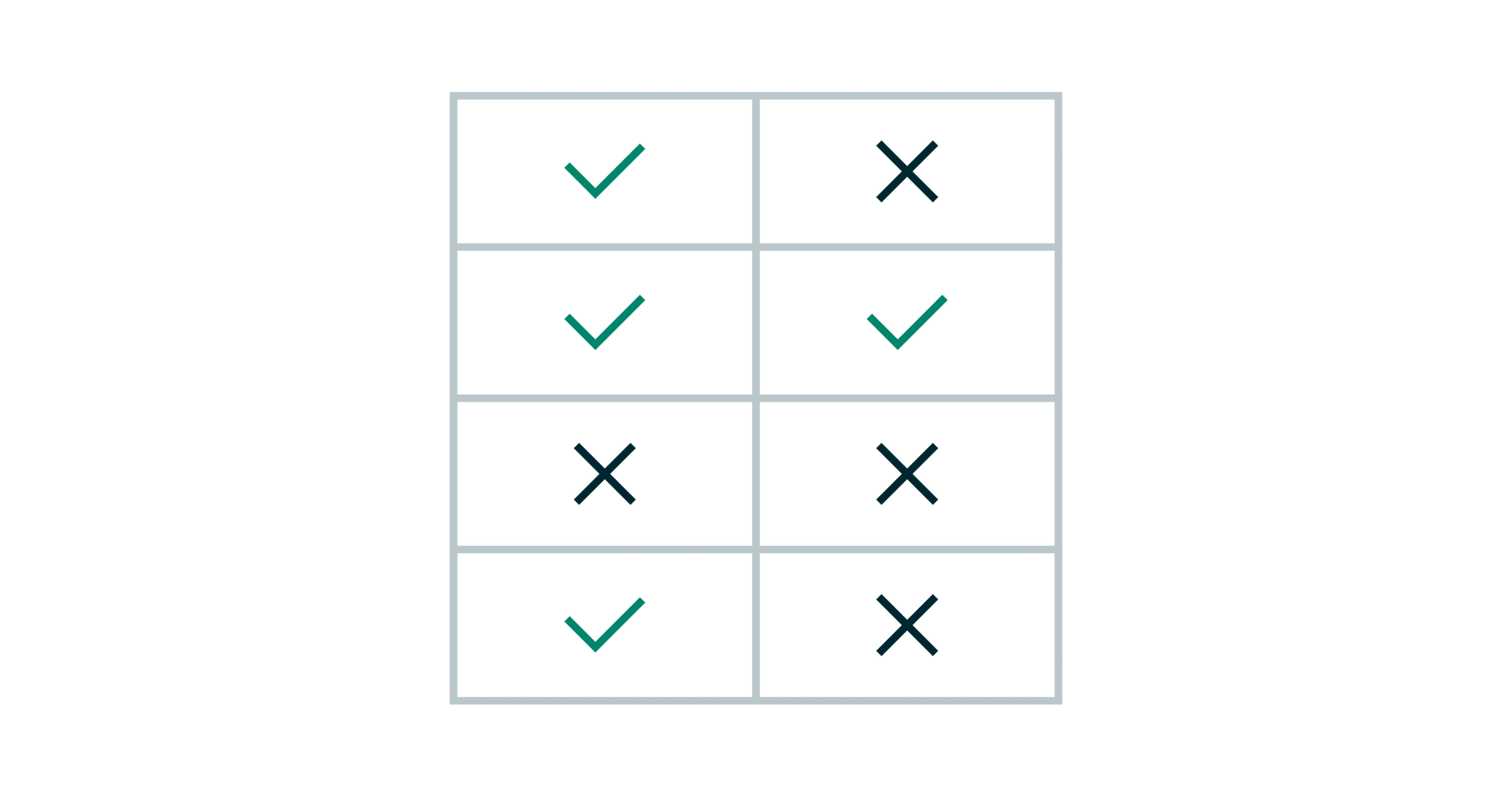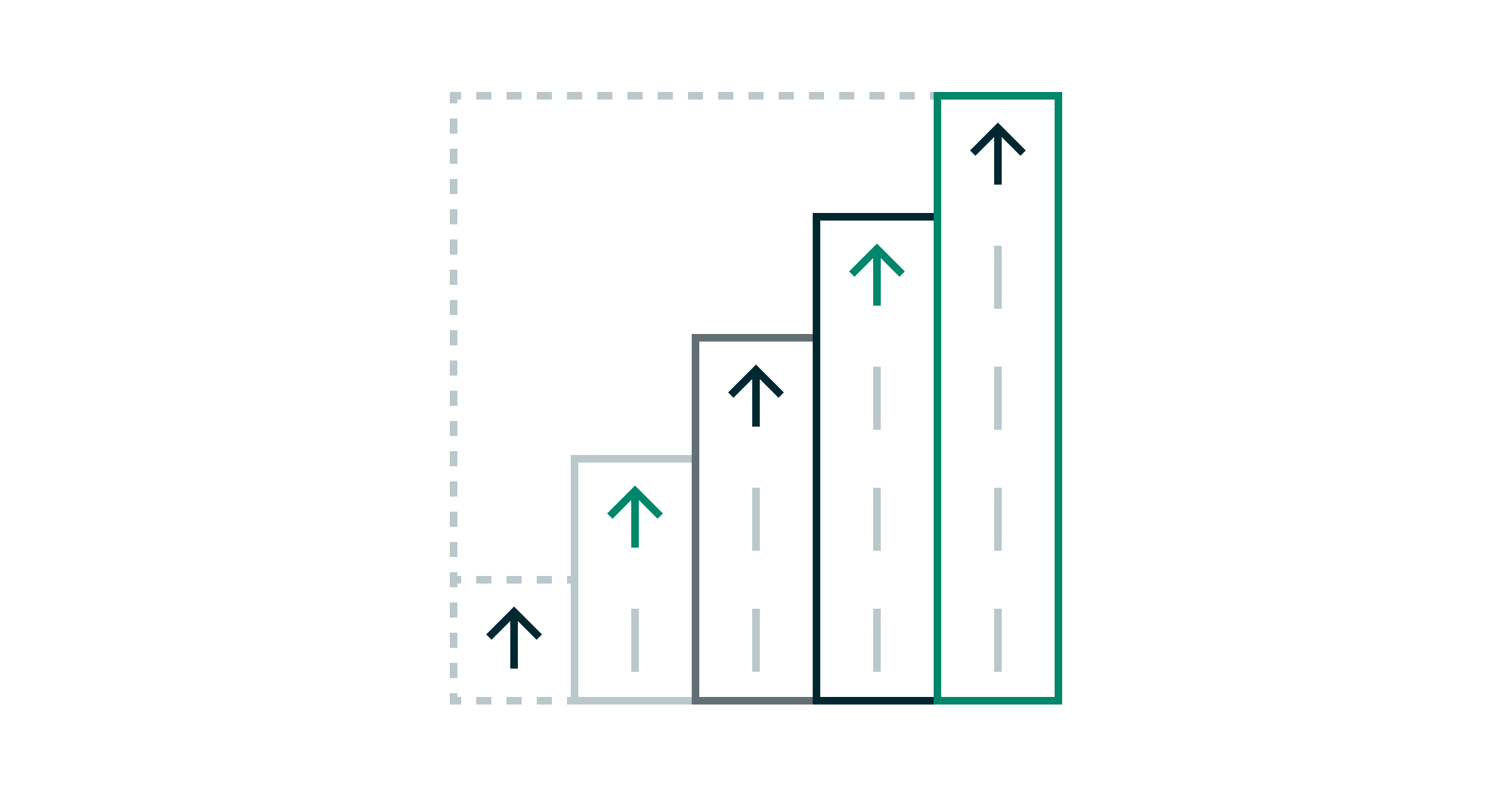Quantive is now part of WorkBoard. Get to know WorkBoard:
We’re doing business at a time when budgets are tight, ambitions are high, and optimization is always a priority. Finding the right solution to meet your business needs can be challenging in such conditions. We get it, and we want to help.
If you are a business leader who wants to improve strategy management at scale and take advantage of technology and artificial intelligence — this article is for you. We know you care not only about executing strategies but also about executing the right plan and knowing when things need to change to drive business success.
Right now, you need a platform that empowers a culture of continuous improvement and gives everyone the tools to think strategically.
A platform to leverage AI at every level.
Let’s explore how some of the leading strategy management software in the market can help, compare where they fall short, and compare how Quantive StrategyAI fills the gaps.
The scope of strategy platforms
Before we dive deep into existing platforms and show you their strengths and weaknesses, we want to note that every platform has a scope. Every platform is good at a specific strategy management area:
- Strategic planning - setting the strategic direction and planning the execution
- Strategy execution - doing the actual work and tracking progress on the strategy
- Strategy evaluation - measuring success and adjusting the strategy
Some platforms have great functionalities for strategy execution. Others are perfect for evaluating business health and tracking success. It all depends on your business's biggest needs.
We will introduce you to the leading software providers in each category and compare their tools, strengths, and limitations. We will also focus on how Generative AI tools can now support different areas of strategy management. Ultimately, we’ll help you understand how Quantive StrategyAI ranks among them.
Let’s start!
Strategic planning providers
Strategic planning is when leaders set the company’s direction and goals and explain how to achieve them. In this stage, you examine the current state of the business and create new plans to reach business goals.
You also ensure that everyone in the company understands the required strategy and work. Effective planning requires careful consideration of resources, budgets, timelines, targets, and tools.
Strategy Platforms: Overview
PlanView, Cascade, Workboard, AchieveIt, and ClearPoint are well-known platforms that help you plan, execute, and track your strategy.
Strengths:
- Quick start and easy setup with pre-built strategy models and customizable templates.
- Flexible strategy/goal-setting methodology templates
- Align organizational goals with the company’s vision to ensure focus on key strategic areas
- Some platforms track projects with details like owners, timelines, and descriptions.
- Structured view of KPI metrics, showing how they contribute to overall goals.
- Most platforms assist every new customer with strategy, onboarding, and training support.
These platforms address one important problem in strategic planning - strategy's death by PowerPoint and spreadsheets.
And they're right!
However, all of these platforms assume you already have the capabilities to formulate a plan and focus on helping you execute it.
What don't they do? They don't provide assistance in creating the right plan. They also don't identify the strategic initiatives that will be most effective. All this is clear from the weaknesses of these platforms.
Weaknesses:
- Basic “strategy planner” tools to help you create strategic goals
- Complex strategy models that are difficult to customize
- Limited native integrations that hinder data connectivity
- Limited or overly complex KPI reporting
- Lack of collaborative planning tools like whiteboards
How Quantive StrategyAI excels
We’ve already hinted that Quantive StrategyAI uniquely supports strategy development. And we don’t mean “no one does it like us.” Literally, no platform offers AI-assisted support for creating the plans you will execute.
- AI-powered strategy formulation: Analyze your options based on your company’s strategy and data and develop AI-generated actionable plans, saving weeks or months of manual work.
- Comprehensive planning suite: Set and assign goals, view goal alignment to strategic initiatives, and track progress in real-time with over 170 data integrations, keeping your team informed and focused.
- Plan the right tools for progress tracking: Access customizable reports and analytics for complete strategic progress visibility at every stage of the strategy management cycle.
- Collaborative planning: Enhance cross-team coordination for a transparent and engaging planning process with shared strategic analysis, executive plan summaries, digital whiteboards, and more.
Quantive StrategyAI keeps your strategic planning efficient, aligned, and effective.

Strategy execution providers
Strategy execution is where leaders and teams put the strategic plan into action. This stage involves organizing resources, starting initiatives, and tracking progress. It requires clear communication, teamwork, and regular check-ins to ensure everyone moves in the right direction.
During execution, you focus on keeping things on track, ensuring everyone stays accountable, and making adjustments to meet your main objectives.
Strategy Platform: Overview
Cascade, Workboard, AchieveIt, ClearPoint, Profit.co are some of the most recognizable strategy execution providers. Workboard and Profit.co are especially popular among enterprises focusing on strategy execution with OKRs (Objectives and Key Results).
All platforms aim to replace manual goal tracking with a comprehensive platform that helps teams stay aligned and track goal progress efficiently.
Strengths:
- Visual tools to align strategic goals, showing how team objectives align with broader company goals.
- Clear ownership of each goal, driving accountability, focus, and an outcome-driven approach.
- Structured goal tracking to monitor progress over time and adjust efforts as needed.
- Allow users to link specific tasks to larger goals to help teams stay aligned and minimize the risk of wasted efforts on low-priority work.
- Most platforms provide some level of automation for goal tracking, saving time, and reducing manual updates.
- Regular update reminders help sustain engagement and inform leaders about the latest progress.
Weaknesses:
- While some platforms provide AI assistance during initial goal setting, there is often minimal guidance throughout the strategy execution process beyond goal creation.
- Many platforms have limited native integrations that hinder real-time data tracking and the ability to link goals and metrics across your systems.
- A common drawback is that these platforms often have rigid frameworks, limiting users' ability to customize dashboards, workflows, or goal structures.
- Many of them are limited regarding workflow automation to help you do things faster for the most efficient execution.
How Quantive StrategyAI excels
In contrast to platforms that can feel overly complex in execution, Quantive’s intuitive UI, automated workflows, and robust KPI tracking streamline goal management and progress tracking.
Unlike other platforms, Quantive StrategyAI redefines goal tracking by actively guiding teams with actionable AI insights to stay laser-focused on your strategy. This makes strategy execution inclusive, engaging, and cohesive across departments, with tools designed to align every team member with shared objectives and regular updates.
- AI guidance on every step: Quantive StrategyAI provides AI assistance for goal creation and execution. This guidance offers real-time data-backed recommendations to refine initiatives and improve outcomes at every stage.
- Out-of-the-box reporting and custom automation: Quantive StrategyAI streamlines workflows to save time and reduce manual tasks. These capabilities boost overall efficiency and execution focus.
- 170+ ready-to-use integrations: Quantive StrategyAI allows seamless data syncing across your platforms. These integrations ensure you embed goals where the work is happening and share updates across all initiatives without delays.

Strategy evaluation providers
In strategy evaluation, leaders actively review the strategy's performance. They assess progress, measure results, and adjust to keep everything on course. Leaders ensure that teams meet goals, identify areas for improvement, and confirm that the strategy aligns with the organization’s direction.
This continuous review process keeps the strategy effective and responsive to any changes.
Strategy Platform: Overview
In the strategy evaluation space, the platforms are split into two categories:
- Strategy platforms like Cascade, Workboard, AchieveIt, ClearPoint, Profit.co
- Business intelligence (BI) tools like Power BI, Tableau, Domo, Qlik, Datapine, Zoho Analytics, Looker
Both software categories help organizations monitor company metrics and performance through dashboards. BI tools lack strategy and goal-related capabilities because users primarily use them for tracking performance metrics. We will focus this comparison on the strategy platform.
So, how do strategy platforms help you monitor success?
Strengths:
- Visual goal progress dashboards for easy-to-track achievements
- Some tools offer metric tracking to assess business performance and the impact of the work.
- Some platforms allow users to define tasks and see how goals influence each other.
Weaknesses:
- No advanced or AI-driven insights that would support better decision-making and uncover blind spots.
- Limited integrations for automating updates to goals and KPIs, which in turn increases manual effort and slows progress updates.
- Dashboards that can’t integrate with external data for a more comprehensive view of business performance alongside strategic objectives.
How Quantive StrategyAI excels
Quantive StrategyAI brings depth to the evaluation phase.
It ensures that performance goes beyond numbers and that the data transforms into strategic insights that can guide decisions. It unifies your reporting to provide a holistic view of your initiatives, goals, and KPIs.
It brings data out of silos to make sure everyone has the insights they need to refine their plans and adjust their goals.
- AI-driven Insights (beyond simple reporting) to adapt and pivot strategies in real-time
- Customizable dashboards for comprehensive performance dashboards and strategic progress tracking
- Custom executive dashboards bring in third-party data for smarter decisions.
- Real-time alerts and proactive risk management for quick responses to changing conditions
- Team check-ins and goal confidence levels for early identification of potential risks

Bonus comparison
Quantive StategyAI vs. ChatGPT vs. Perplexity.AI
When it comes to creating a strategy, sometimes, we get questions about the difference between Quantive StrategyAI and other AI-based machine learning models. Quantive StrategyAI indeed has rapid data processing and strategic analysis capabilities like other AI tools. However, these tools require skilled prompting to get your desired assistance.
Generative AI tools are not built to be a strategist. Quantive StrategyAI is.
Also, remember that only our strategy formulation module directly compares to other generative AI chatbots because it uses an AI assistant for real-time conversations, analysis, strategic hypotheses generation, and decision mapping.
Quantive StrategyAI uses generative AI to support businesses in end-to-end strategy management. The AI assistant evaluates the health of existing strategies and helps generate hypotheses to refine strategy. Unlike general content-generation tools, Quantive’s AI delivers integrated strategic insights, data analysis, and goal-setting capabilities tailored to your business case at each step of the strategy management cycle.
ChatGPT is a conversational AI model. People mainly use it for tasks that require an understanding of natural language. These tasks include content generation, answering questions, and having human-like conversations.
It's versatile and can cover many topics. However, without clear prompts, users might struggle to make strategic decisions.
Perplexity.AI functions more like an AI-driven search engine. Its main strength is in retrieving and summarizing factual information from multiple sources, focusing on fast, accurate responses to search-style queries. It's great at providing quick answers and summaries, but it is not the tool you want for creating strategic plans.

How is Quantive StrategyAI better?
- Built to be a strategic advisor for guided decision-making with the power of AI
- Makes strategic analysis collaborative by letting everyone contribute to the same analysis notepad and decision map
- Dives deep into your business data and context to generate highly relevant insights, hypotheses, and strategic choices.
- Creates a detailed plan and lets you customize it based on your business needs
- Knows everything about your business and helps you make decisions that fit your context
- Ensures your business data is secure and only available to you, not to the platform.
The complete strategy software comparison cheatsheet
This overview shows you how the existing providers compare to each other and Quantive StrategyAI.
Want a deeper dive? Download your complete cheatsheet now.
Ready to transform the way you manage your company strategy? Contact us to learn more about how Quantive can help your organization drive better, faster strategic results.





